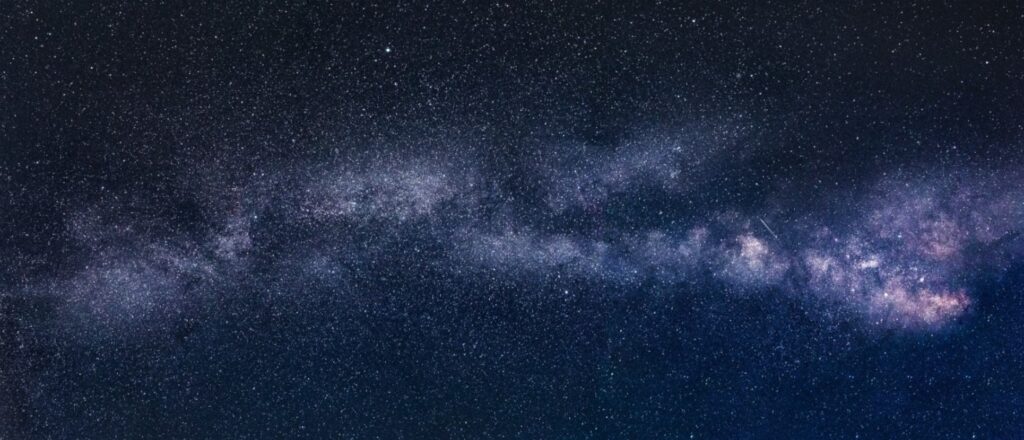The Night Sky and our Well-Being

Most of the time, whether we are moving or staying still, our eyes focus on what is in front. We are continuously preoccupied with the busyness that surrounds us and behaves as if we are the centre of everything. But now and then, if we tilt our heads up to the sky at night long enough, we might sink into oblivion pondering the vastness of what is above.
The Night Sky
When the sky is clear, I can see with my naked eyes the planets Venus, Jupiter, Saturn and Mars at night or in the early morning. When conditions are good, I can easily spot the 3 dots that identify the Belt of Orion—even in light-polluted Singapore where HDB flats and skyscrapers obstruct our view of the horizon. The view is clearer if you move up north to the darker skies in Malaysia. I remember lying on a beach in Malaysia’s east coast with my school friends decades ago looking up at blinking stars that make up the night sky. Though I wondered about the infinity of it all, there was too much life ahead and little life experience to be humbled for too long about the meaning of my existence.
It was only much later that I began to wonder much more about the fleeting blip of life when I saw the fuzzy stretch that is our Milky Way Galaxy during a family holiday in Tasmania. Strangely, knowing the fact that our puny life span is so inconsequential compared to 14 billion years of the existence of the Universe is quite liberating. It has given a fillip to my quest for better understanding of all the wondrous things in the Universe—not that I will ever know the answer to life, Universe and everything. Knowing for the sake of knowing is a pleasure in itself, much like music, the sight of beautiful things, the taste of fine food and other delights of the senses.
Looking up at the night sky seems the obvious path towards understanding the mystery of the Universe. Since the time when Galileo aimed his homemade telescope at Jupiter’s moons (1610) to the current last throes of the Hubble Space Telescope, scientists have discovered so much about our Universe. It is akin to an ant being able to read the mind of human beings. We have estimated the age of the Universe, photographed the remnant radiation of its birth and detected ripples caused by the collision of black holes 17 billion light-years away! There is so much astonishing stuff to marvel at.
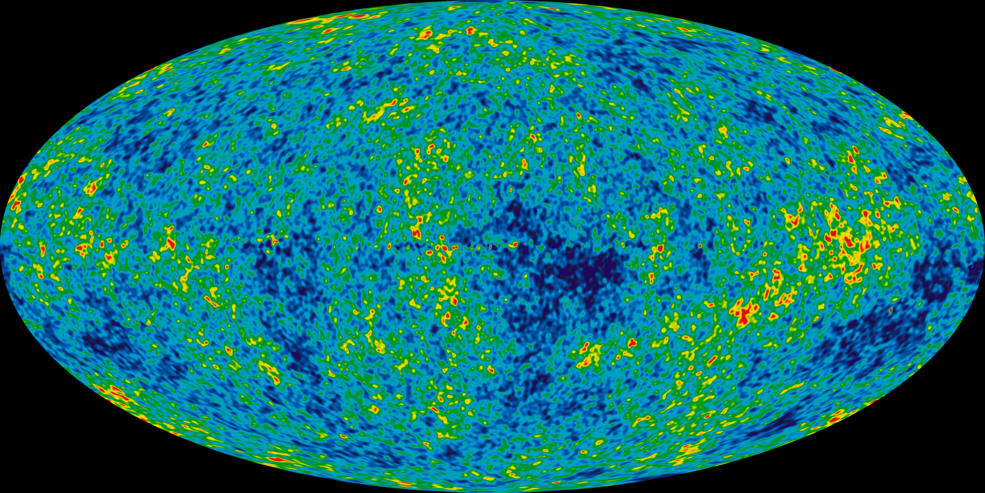
I did not have much interest in astronomy when I was growing up. Like many other kids of my generation in this mercantile nation, our preoccupation was firmly based on earthly endeavours, mostly of the economic kind. Moreover, the night sky is not an in-your-face encounter in our daily life, given our preference for indoor living and the safety of bright lights after twilight sets in. I was largely indifferent about what hangs in the night sky in my backyard. I just assumed that nothing much can be seen beside the moon in our light-polluted city.
It was only when I stopped work a few years ago and started walking my dog in the early hours before dawn that I became aware of how bright some of the planets were in the sky. With the help of some websites (see below), I was able to identify faraway stars and the visible planets easily.
- Time and Date AS https://www.timeanddate.com/astronomy/
- The Sky Live https://theskylive.com/
See it for yourself
Just to show how we take for granted the wonder up in the sky, I took some pictures just around my home before dawn and at night recently. I used my phone camera, just like I would in my daily life when something catches my attention. The quality of the pictures is not great because of light pollution. Like everywhere else in Singapore, you cannot walk more than ten meters without hitting a brightly lit lamp post—such is our fear of the dark. But the point is to show how accessible the planets and stars are to the naked eye even under such harsh light environment.
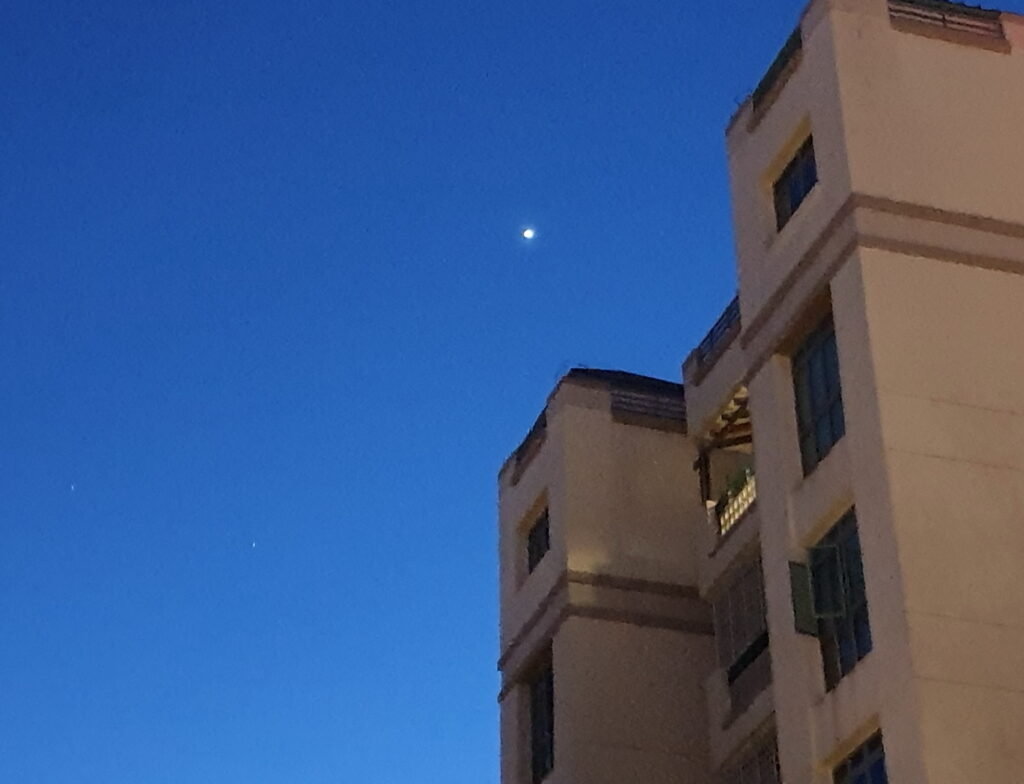
The above is a picture of Venus just before sunrise, hence the blue sky. Venus is so bright that I am ashamed I have not noticed it before. Apparently, I am not alone judging by the reaction of old school friends when I alerted them on our Whatsapp group. Depending on its trajectory relative to the Sun, Venus is revealed to us in the evening or at dawn, thus the term evening star and morning star we sometimes come across in stories and literature.
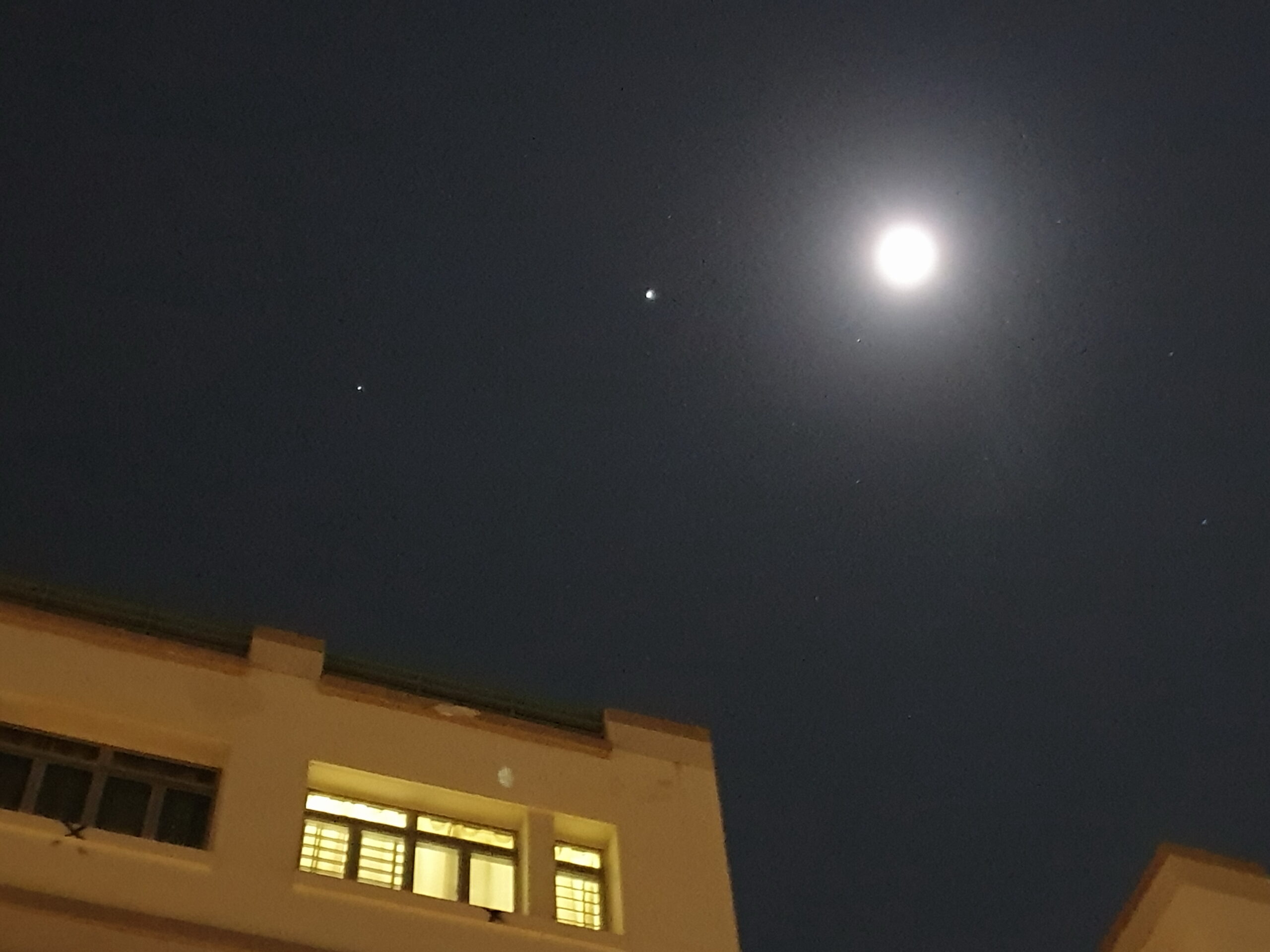
This view was taken directly above my head when I stepped out from my lift Lobby about 9 pm at night. The brightest object is of course the moon. Next to it on its left is Jupiter, followed by Saturn. Jupiter is quite easy to spot (brightest after Venus), and I usually see it either at night or before dawn, depending on when it rises and sets. Actually, I had seen a close-up view of Jupiter through a telescope set up by a side-walk astronomer while walking with a friend in Los Angeles. It was a mesmerizing view, and I thought I would pay more attention to the night sky when I come back home—but alas, the pull of busy work life is stronger than the delightful views of heavenly bodies.
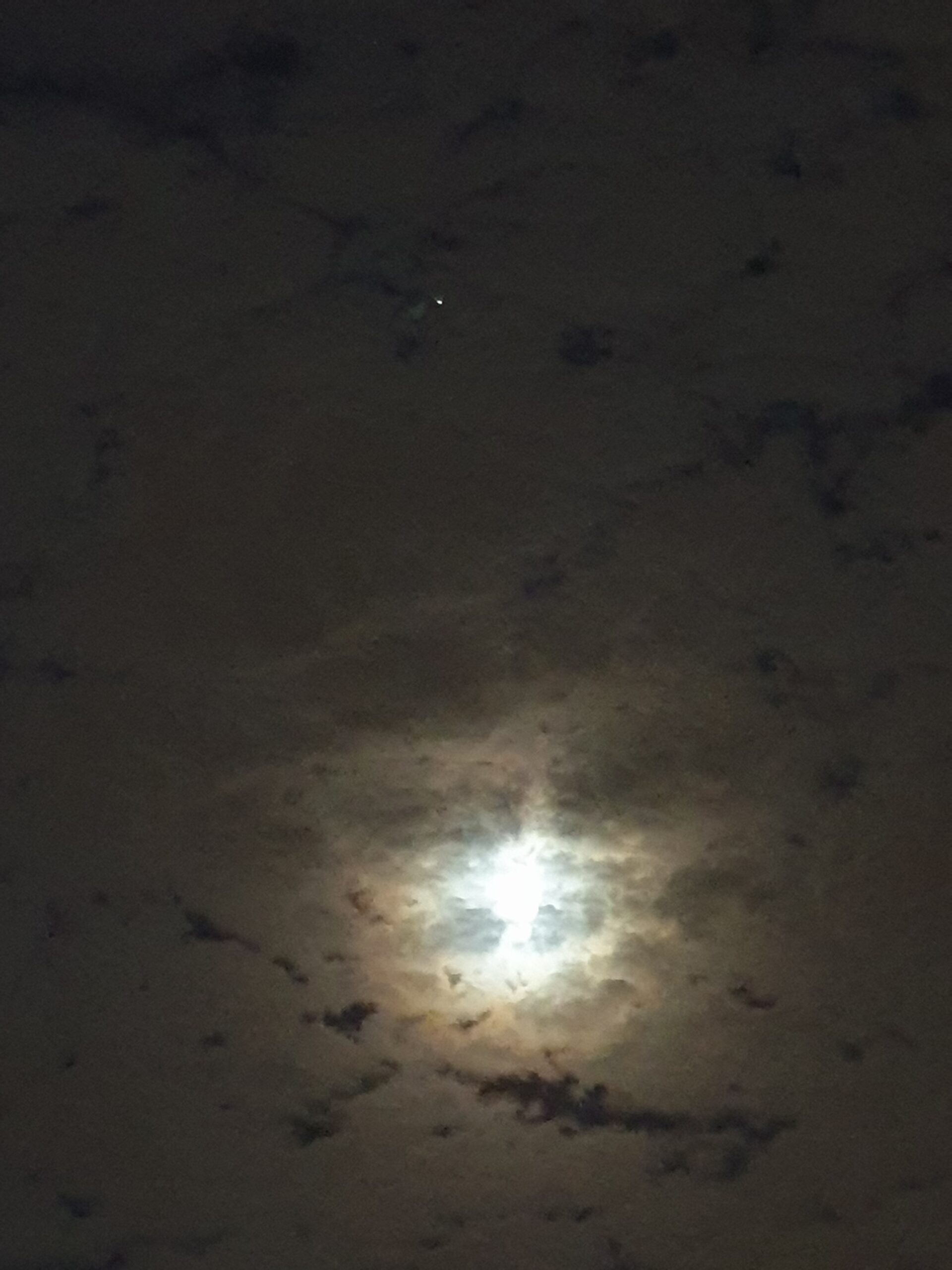
A dramatic picture of Mars just peeping out from the cloudy morning sky against the luminous moon
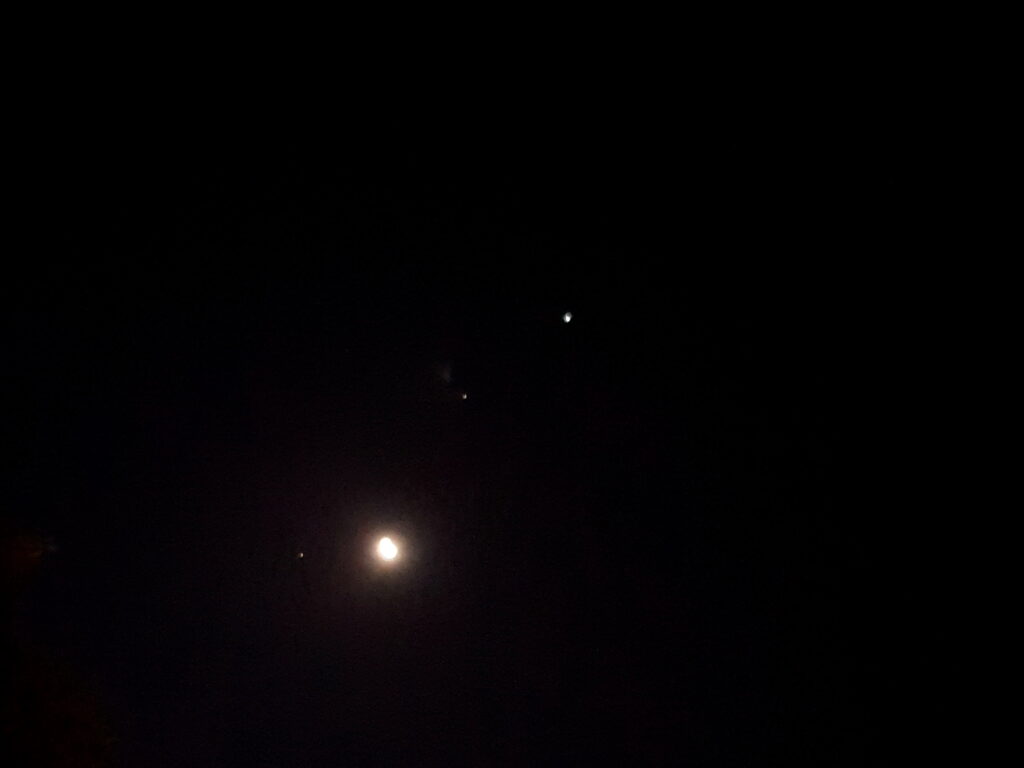
This is a picture taken earlier in April this year when the moon and the 3 most visible planets Mar, Saturn and Jupiter can be seen together.
Constellations
Besides planets, we can see quite a fair number of stars in the far reaches of space. The ancients identified the numerous stars by grouping them into regular patterns called constellations that seem to appear in fixed regions in their revolving night sky. The constellations were mostly named after Greek mythology, animals and ancient objects. There are now 88 officially recognized constellations, of which about 50 of them are known in the ancient world. One constellation that is visible throughout the world because it lies above the equator is Orion the Hunter.
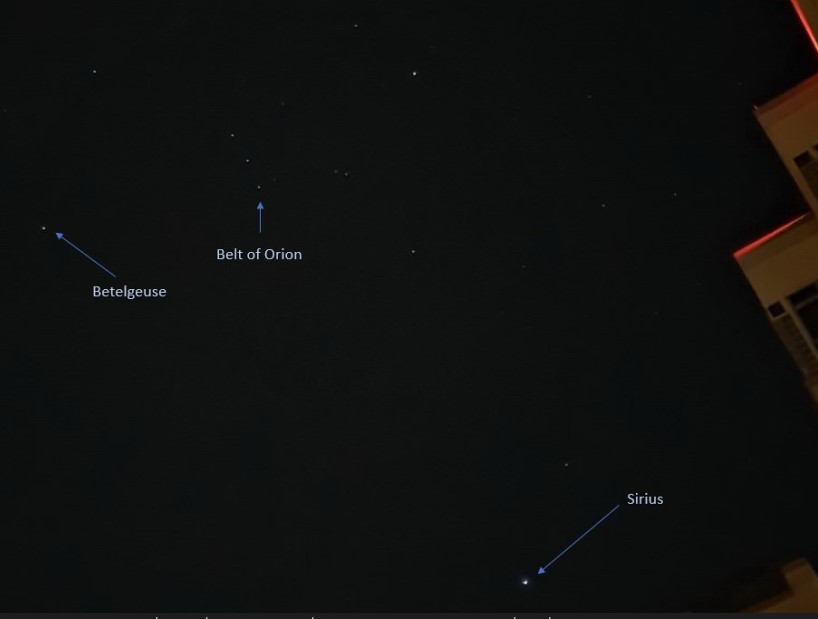
I am afraid this picture of the Orion constellation may not be so visible especially if you are reading this post on a mobile phone. The stars may be a bit faint, but they are clearly visible with your naked eyes on a clear night. Orion’s belt is marked by the distinctive 3 dots. Somewhere to the right, and perpendicular to it are a few faint dots which is Orion’s sword. My aged naked eyes could not see it clearly, but it shows up better in the picture, thanks to the automatic image processing capability of my mobile phone. Further to the left is the reddish-orange star Betelgeuse (pronounced “Beetlejuice”). It is what the astronomers called a red supergiant, which will explode as a supernova anytime now to the next 100,000 years, which in astronomical terms, a very short time.
Outside of the Orion constellation, further down to the bottom right of the picture, you can see Sirius, the brightest star visible to the naked eye in the night sky. Known as the dog star, it belongs to the constellation Canis Major. Interestingly, the Chinese (using a different constellation system from the West) call Sirius the “Celestial Wolf” (天狼) star while other disparate cultures such as North American natives, indigenous people in Australia and ancient Mesopotamian also associate Sirius with the canine family. Is this a coincidence, or is there a mysterious anthropological thread running through it?
The immensity of the Universe
Our solar system is huge by any earthly measures, between 9 to 289 billion kilometres wide depending on how you measure it. The former is the orbit of the furthest planet Neptune and latter, the edge of the sun’s gravitational influence. These are huge numbers to ponder in relation to our daily lives. If we fly at the speed of the fastest commercial plane today, we have to live more than 7 lives to travel from Earth to Neptune, and 460 lives to escape from the sun’s influence.
Even so, our solar system is just a speck of dust compared to the size of the Milky Way Galaxy where stars such as Betelgeuse and Sirius lie. It is so big we cannot use terrestrial means to measure and describe it. Instead, we resort to “light years”, the distance that light travels in a year, which works out to be about 9.5 trillion kilometres (i.e. 9,500,000,000,000). The Milky Way, which is a spiral disc, is estimated to be about 100,000 to 200,000 light-years in diameter! Multiply that with 9.5 trillion kilometres and see whether your brain can digest the distance meaningfully.
Our small speck of a Sun lies in one of the spirals of the Milky Way, among 100 to 400 billion other stars. Within each star, they must be other planets, moons and celestial objects just like our solar system. Thus, the size and the number of bodies contained in our galaxy are mind-boggling. Yet, that is not all. The Milky Way is not the only galaxy! It is estimated that there are at least 2 trillion other galaxies! There must be more than septillions (a number with 24 zeros) of stars, and that is just in the observable Universe.
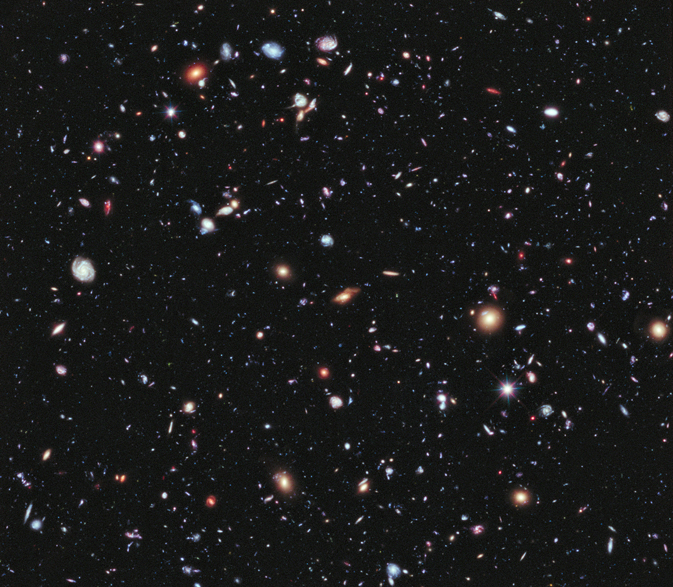
After knowing all this, measures such as billions, trillions, septillions and other astronomical scales become quite meaningless in ascertaining our place in the entire Universe. Understanding and manipulating enormous numbers intellectually is easy, imagining it is quite impossible. The vastness of one billion is the same vastness of one septillion in our mind. We can only gasp in awe just thinking about implausible things and events that might exist in this vast space, including our very own existence.
If thinking about it gives us goosebumps, seeing the Milky Way and the mist of stars with our own eyes will only daze us no end. Though we do not see a star-studded sky in Singapore even in the best of nights, if we stare long enough to let our eyes adjust to the darkness, there are enough tantalizing clues of unending deep space filled with sparkling celestial bodies. Better still, make a trip (after COVID-19 saga) to Tasmania or places where the night is left alone and unlit.
Being awestruck
One would think that the awe in contemplating the boundless Universe against our negligibly tiny and insignificant self may cause us despair and gloom. By right, once it sinks in that our life is shorter than a blink in the mighty Universe, we should immediately fall apart in an existential crisis. Yet the opposite usually happens; we become more appreciative of life and connected to others. Perhaps experiencing the awe of the Universe jolt us off our ego-centric pedestal and throw us together with every other being, animal, vegetable and mineral. 400 year ago, Copernicus and Galileo dislodged the earth from the centre of all in heaven (and attracted the wrath of the Inquisition). Subsequent discoveries also kicked out the Sun and the Milky Way Galaxy as the pivot of the Universe. All these serve to confirm our humility of being just like the other guys in the room, leading us to be less narcissistic and more humane.
In the last 20 years, researchers studying the psychology of awe found that our experience with it usually leads to positive outcomes and changes. This includes being more humble, generous, altruistic, prosocial, and empathetic towards others. Some studies claimed that people who experienced awe tend to think more critically (much needed in this world flooded with fake news). They feel more connected to others, has a dampened desire for materialism, become more spiritual oriented, enjoy an increased sense of well-being and have better satisfaction with life. Interestingly, they also have an expanded perception of time, making them more willing to spend time helping others rather than complain about lack of time.
Summer Allen, a science writer summarized some of these findings in “The Science of Awe”, a white paper published by The Greater Good Science Center at the University of California Berkeley (see below). It must be noted that “awe” in these studies refer to a range of triggers. We can be awestruck by physical phenomena (such as nature), social situations (e.g. charisma or fame of individuals), spiritual encounters (religious and non-religious), artistry (e.g. virtuosic music or insightful artwork), and even complex thoughts (e.g. understanding quantum physics and the theory of relativity). However, being awestruck by the vastness and improbability of the Universe seems to be one of the more accessible ways of experiencing wonder for most of us.
https://ggsc.berkeley.edu/images/uploads/GGSC-JTF_White_Paper-Awe_FINAL.pdf
A wish
Now, if only we can shoo away all the clouds and switch off all the lights in Singapore for one night, we will all be awed by the majesty of the Universe and perhaps become less complaining and better people.
